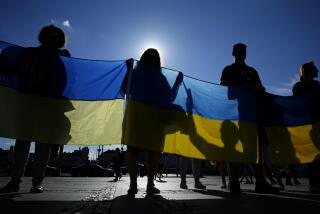PERSPECTIVE ON THE SOVIET UNION : Did We See Change That Wasn’t There? : Beneath the veneer of reform lie disturbing continuities in Soviet policy that are being ignored.
- Share via
Soviet Foreign Minister Eduard A. Shevardnadze resigned supposedly because he fears the emergence of dictatorship. Could it be possible that this event will jar official Washington out of its extraordinary confidence about the future of Soviet reforms?
For months, it hardly has been possible to discuss East-West relations without having to pay obeisance to half-truths that have fostered this confidence: “The Soviets have changed. Marxism-Leninism is dead. Therefore, the Cold War is over, and we won. Now, we can look forward to a new world order and a peace dividend.”
The more this is repeated, the more difficult it is to challenge. And yet, because it is only partially true, and because its implications are so great for U.S. national security, it needs to be questioned seriously.
The Soviet Union has changed and is still changing. The question is: Has it changed in such fundamental ways that we must redraw our entire national security policy, or are there continuities that should give us pause?
Continuity in the economy-- While we must wait a year and a half to see results from the 500-day plan, its original authors have already pronounced both the Soviet and the Russian versions as failures. This is because the authorities have declared the necessity of reimposing “administrative measures”--a euphemism for centralized control--in order to avoid “catastrophe.” Another reason is the continued ideological resistance to private property. As Mikhail Gorbachev’s own economist, Abel Aganbegyan, said, “Privatization is not a switch to private property.”
Without a political-legal structure to support genuine private property, the highly touted “reforms” like land-leasing and cooperative ventures are failing.
Legislative continuity-- There is a new Congress of Peoples’ Deputies, which may prove to be the incubator of genuine, organized opposition movements. But, thanks to deft manipulation by the Communist Party, new and improved Supreme Soviet, the Congress’ full-time subsidiary, has a larger percentage of party members than its discredited predecessor.
The party has restricted the Congress to being little more than a pressure-release valve, a debating society with little actual power. The laws it has passed are either so inconsistent with the constitution, so violated by administrative practice or so lacking any right of judicial appeal, that one wonders whether they might not be more reasonably called “occasionally enforced legislative policy declarations.” A “rule-of-law” state just does not yet exist.
Political continuity-- There has been a lot of talk about the death of Marxism-Leninism and the irrelevance of the Communist Party. While it is suffering an ideological crisis, the party is very much alive and feverishly searching for a way to “renew” socialism. Gorbachev himself has said that perestroika is not the dismantling of socialism but “the revival of creative Marxism.” The antipathy toward capitalism is pervasive, as is the desire for centralized power. And materialism remains the party’s philosophical foundation. What is missing is consensus on the best way to regain legitimacy for socialist ideas.
We have seen the extraordinary rise of national movements, declarations of sovereignty and independence by the various Soviet “republics” and the creation of new political groups, movements and opposition journals. But all this notwithstanding, the party still has the monopoly of force over Soviet territory. It still controls the KGB and the armed forces. It has beefed up the internal militia by adding troops withdrawn from East Europe. It has given the various security forces new “emergency” powers. It has unabashedly imposed martial law in Armenia, gassed demonstrators in Georgia, deployed massive force to control Azerbaijan and blockaded Lithuania. And according to leaders of the national democratic movements, it has promoted inter-ethnic conflicts in classic divide-and-rule tactics.
Continuity in foreign policy-- While the Kremlin has relinquished direct control of most of East Europe, a large number of its Cold War policies continue elsewhere.
Despite reports that Moscow is significantly diminishing its subsidies to Cuba, it still sends billions to its Latin client, which in turn continues to funnel arms to the Marxist guerrillas in El Salvador. The Soviets continue to support their clients in Afghanistan, Ethiopia, Angola and elsewhere. Intelligence sources reported the movement of Soviet arms to Iraq a month after the embargo began. The Soviets are training Iraqi military personnel in the Soviet Union, and they have not been honest about the large number of their military, technical and intelligence advisers stationed in Iraq.
Modernization of the Soviet military proceeds at a rapid pace, with a $50-billion budget increase for 1991, in spite of apparent economic depression and the new rapprochement with Washington. According to several Western intelligence chiefs, KGB activities against the West have intensified. Meanwhile, Moscow’s peace propaganda campaigns have helped anesthetize most American concerns about Soviet strategic purposes.
In sum, beneath the veneer of “reformed socialism,” economic “restructuring” and “legislative” maneuvering lie disturbing continuities in Soviet policy that are being ignored by our own policy-makers. As a result, our dealings with the Soviet Union are based entirely on hopes that the demise of Soviet communism is near completion and irreversible. Hopes are a poor foundation upon which to build a future of peace and security.
More to Read
Sign up for Essential California
The most important California stories and recommendations in your inbox every morning.
You may occasionally receive promotional content from the Los Angeles Times.












